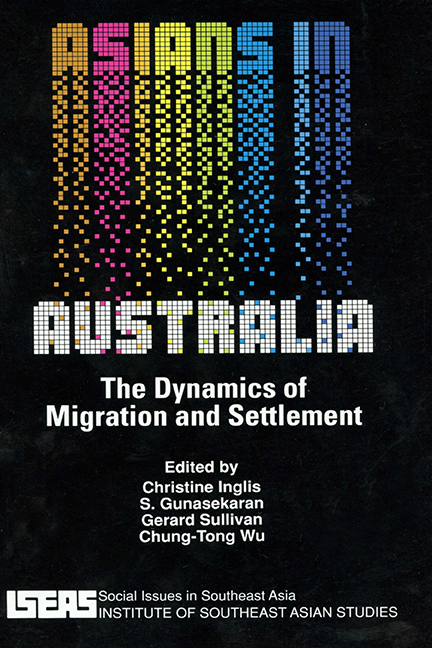Book contents
- Frontmatter
- Contents
- List of Tables
- List of Figures
- Introduction
- 1 China's Policy Towards Migrants, 1842–1949
- 2 Japanese Emigration Policy, 1880–1941
- 3 The “New” Migration and Australian Immigration Policy
- 4 Patterns of Settlement in Australia of Indochinese Refugees
- 5 Labour Market Outcomes Among the Chinese at the 1986 Census
- 6 Is There An Asian-Australian “Brain Drain”?
- 7 The “New” Migration of Asian Skills and Capital to Australia
6 - Is There An Asian-Australian “Brain Drain”?
Published online by Cambridge University Press: 21 October 2015
- Frontmatter
- Contents
- List of Tables
- List of Figures
- Introduction
- 1 China's Policy Towards Migrants, 1842–1949
- 2 Japanese Emigration Policy, 1880–1941
- 3 The “New” Migration and Australian Immigration Policy
- 4 Patterns of Settlement in Australia of Indochinese Refugees
- 5 Labour Market Outcomes Among the Chinese at the 1986 Census
- 6 Is There An Asian-Australian “Brain Drain”?
- 7 The “New” Migration of Asian Skills and Capital to Australia
Summary
Introduction
The issue of migration to Australia has become controversial at both ends of the migration chain. One argument used by some who oppose such immigraton to Australia is that many of these newcomers are of “low quality” in terms of occupational skills that are in demand in Australia, and that many migrants become tax burdens because of the unemployment benefits that they consume.
Concern about migration has also been expressed in some of the sending countries. Political leaders and the mass media in these countries have suggested that those emigrating are most likely to have high educational attainment and business skills, and are therefore the people most needed to promote economic development in their own countries. In Hong Kong, Malaysia, Singapore and the Philippines, press reports have suggested that migration is responsible for the shortage of people in various occupational categories (for example, Straits Times, 4 December 1988, p. 15; 14 December 1988, p. 12; 27 September 1988, p. 5; 10 October 1988, p. 7; 9 January 1989, p. 16; 19 January 1989, p. 9; Lee 1987). In this chapter the validity of these arguments is examined from an empirical viewpoint. The question of whether or not there is a “brain drain” from Southeast Asia to Australia is also investigated, by looking at the occupational skills that immigrants from Southeast Asia and Hong Kong bring to the Australian labour force.
The first section provides background information to the “brain drain” — “brain gain” discussion which follows and establishes baseline data from which an evaluation of immigration from these source countries can be made. The rate of migration from these sending countries in recent years is ascertained and some of the methodological difficulties in determining the flow of Asian immigrants to Australia from available sources of data are discussed. This is followed by a brief review of the criteria for admission to Australia under the various categories of the immigration programme and the proportion of immigrants from Southeast Asia and Hong Kong which fall into each category.
- Type
- Chapter
- Information
- Asians in AustraliaThe Dynamic of Migration and Settlement, pp. 157 - 192Publisher: ISEAS–Yusof Ishak InstitutePrint publication year: 1992



